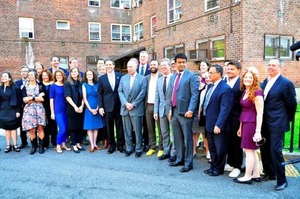ARCHITECTURE & DESIGN
The Big U wins design competition. The design competition provides innovative ways to deal with climate change Image courtesy of BIG and Dutch One Architecture
DESIGN COMPETITION: Big U has been selected to receive $335 million in “rebuild by design,” a year-long design competition among ten multidisciplinary design teams and a total of 148 international applicants.

The Announcement Ceremony for winners of the design competition. Image courtesy of BIG and Dutch One Architecture
NEW YORK, NY— Big U, co-developed by BIG and Dutch One Architecture, has been selected as one of six winning solutions to protect U.S. cities from increasingly intense weather events. The announcement was made Monday by The Secretary of the U.S Department of Housing and Urban Development, Shaun Donovan. In attendance were NYC Mayor Bill de Blasio, Governor Andrew Cuomo, Senator Charles Schumer, and Zia Khan of the Rockefeller Foundation.
Founded in 2013 as a response to Hurricane Sandy’s devastations, Rebuild by Design called for an innovative community- and policy-based solution to promote resilience in the Sandy-affected region. Big U is selected as one of the winners of the year-long design competition among ten multidisciplinary design teams and a total of 148 international applicants.
“The winning proposals are truly transformative and serve as blueprints for how we can safeguard the region and make it more environmentally and economically resilient,” said Secretary Shaun Donovan. “It’s my hope that Rebuild by Design will inspire other public-private partnerships to spur innovation and resilience in other parts of the country and around the world. By investing in these proposals, we are going to ensure that when the next storm comes, the region will be safer and better prepared.”
Coined the ‘Big U’, the systematic approach encircles Manhattan responding directly to the needs and concerns of the area’s communities. Running from West 57th Street south to The Battery and up to East 42nd Street, the Big U protects 10 continuous miles of low-lying geography that comprise an incredibly dense, vibrant, and vulnerable urban area. The team’s approach is rooted in the two concepts of social infrastructure and hedonistic sustainability. The Big U not only shields the city against floods and stormwater; it provides social and environmental benefits to the community and fosters an improved public realm.
The Big U team envisions three compartments that function independently to provide flood protection. Each compartment comprises a physically discrete flood-protection zone that can be isolated from flooding in adjacent zones. At the same time, each presents opportunities for integrated social and community planning. The compartments work in unison to protect and enhance the city, yet each compartment’s proposal is designed to stand on its own. Bjarke Ingels, Founding Partner, BIG describes the Big U thus:
The Big U is an example of what we call Social Infrastructure. The High Line shows how a decommissioned piece of infrastructure – the abandoned elevated railway – can be transformed into a public space and green landscape. We asked ourselves: What if we could envision the resilience infrastructure for Lower Manhattan in a way that wouldn’t be like a wall between the city and the water, but rather a string of pearls of social and environmental amenities tailored to their specific neighborhoods, which also happens to shield their hinterlands from flooding. The Big U will not only make the waterfront more resilient but also more accessible and inviting to the citizens around it.
Proposed solutions for the components were designed in close consultation with the associated communities and a number of local, municipal, State, and Federal stakeholders; each proposal has a benefit-cost ratio greater than one; and each is flexible, easily phased, and able to integrate with existing projects in progress.
Matthijs Bouw, founder of co-lead One Architecture comments:
The Big U really shows the power of design in building coalitions. In an intensive process with the community, the city and the housing authority we discovered how a well-designed flood protection system can have multiple benefits: housing preservation, improved urban spaces, and jobs. Sometimes people say about climate change that it is really a problem that is shared by everyone. In The Big U, we think that the benefits of investment in protection against it should also be shared.
CDBG-DR funds will be used to implement the first phase of the proposal along the Lower East Side, creating a ‘bridging berm’ at the East River Park. The bridging berm provides robust vertical protection for the Lower East Side from future storm surges and rising sea levels. The berm also offers pleasant, accessible routes into the park, with many unprogrammed spots for resting, socializing, and enjoying views of the park and river. Both the berms and bridges will be wide and planted with a diverse selection of salt-tolerant trees, shrubs, and perennials to create a resilient urban habitat.



